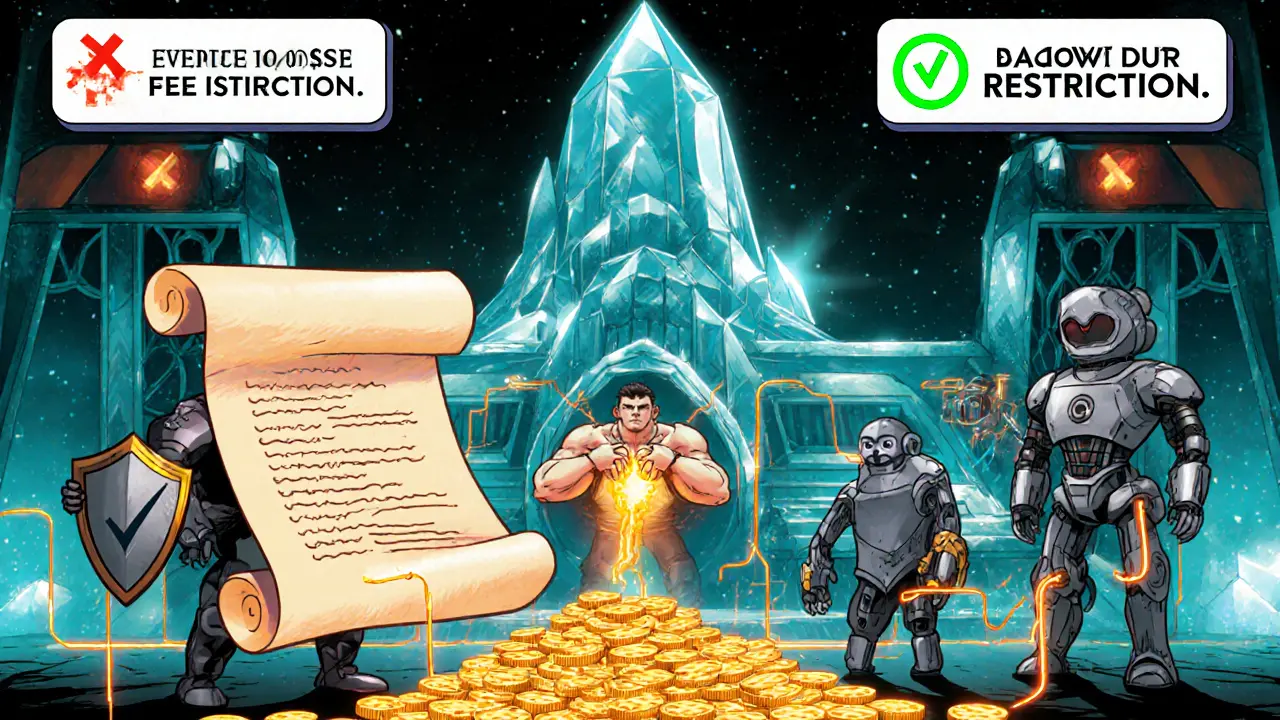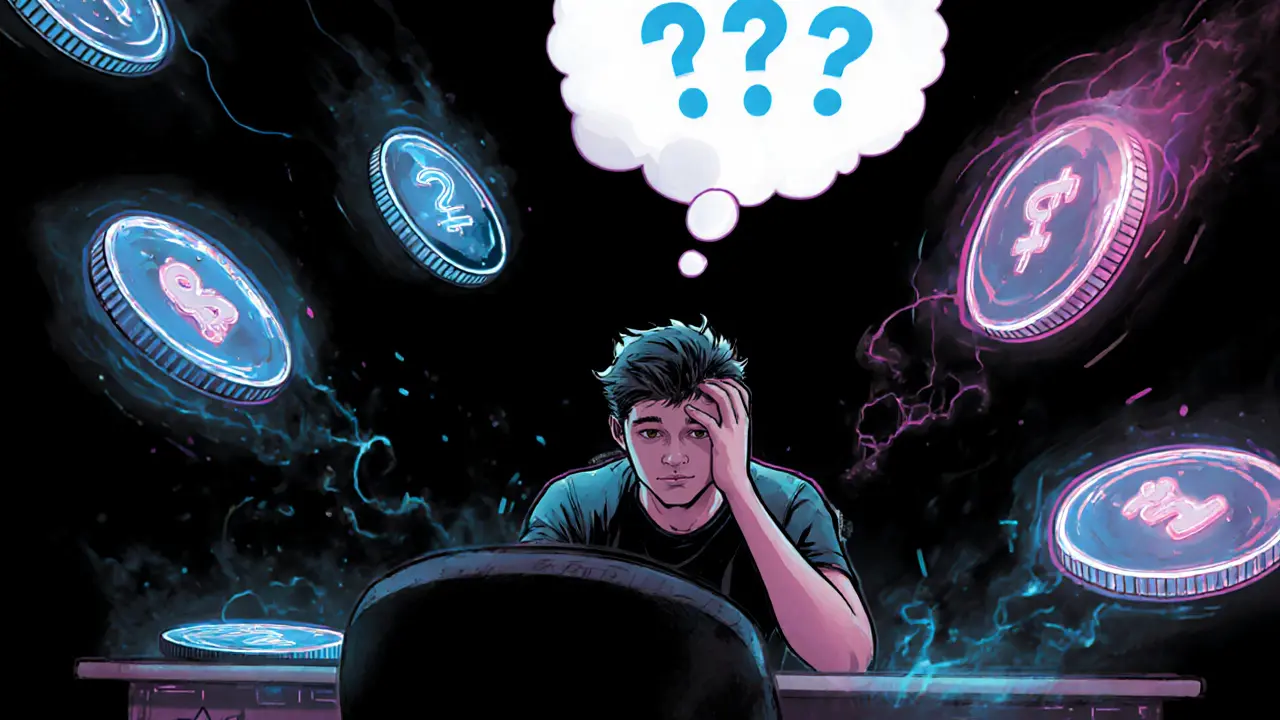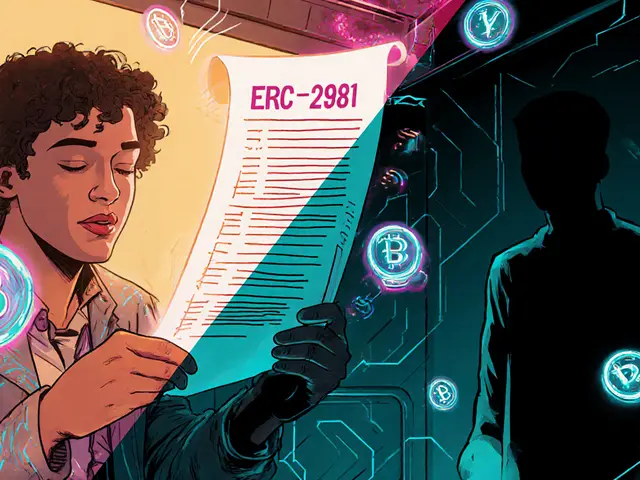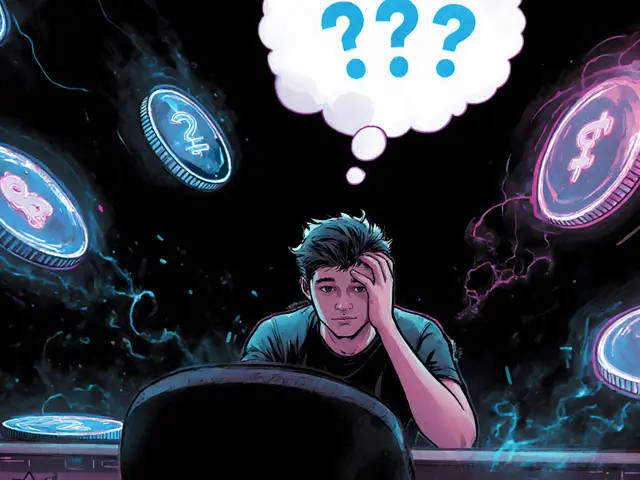NFT Royalty Enforcement Checker
Creators keep asking, "Why does my art disappear into the ether when it’s resold?" The answer lies in how royalties are-or aren’t-wired into the blockchain. In 2025, the most reliable way to guarantee a cut from every secondary sale is to embed the royalty logic directly in the smart contract and let the chain enforce it. Below you’ll learn what on‑chain royalty enforcement actually means, which standards make it possible, how to choose the right restriction model, and what to watch for when you move NFTs across chains.
Quick Takeaways
- NFT royalties are automatically paid when a token is transferred, thanks to the EIP‑2981 standard.
- Enforcement boils down to two patterns: blocklists (deny‑list) and allowlists (whitelist).
- Cross‑chain moves need bridges that translate royalty metadata, otherwise the cut is lost.
- Platforms like OpenSea and Enjin already ship built‑in royalty enforcement; Blur opts for optional royalties.
- Follow the checklist at the end to keep your royalty stream alive without sacrificing composability.
What ‘On‑Chain Royalty Enforcement’ Actually Is
At its core, on‑chain enforcement means the royalty terms live in the token’s code and the blockchain itself validates the payment before a transfer succeeds. No middle‑man, no trust‑game. When a buyer triggers a sale, the smart contract calls a royaltyInfo function, calculates the percentage, and routes the funds to the creator’s address-all in a single transaction.
Two standards dominate the Ethereum ecosystem:
- ERC-721 is the original non‑fungible token spec, handling one‑of‑a‑kind assets.
- ERC-1155 blends fungible, semi‑fungible, and non‑fungible tokens under one contract, offering batch operations.
Both can adopt EIP-2981 - the royalty standard that adds a royaltyInfo(uint256 tokenId, uint256 salePrice) method. The method returns two values: the royalty receiver’s address and the amount owed (salePrice × royaltyPercent / 10,000). Because the data lives on‑chain, any marketplace that respects EIP‑2981 will automatically deduct and forward the amount.
Implementing Royalties in Your Contract
Here’s a minimal Solidity snippet that shows how to bolt EIP‑2981 onto an ERC‑721 token:
pragma solidity ^0.8.0;
import "@openzeppelin/contracts/token/ERC721/ERC721.sol";
import "@openzeppelin/contracts/interfaces/IERC2981.sol";
contract MyArt is ERC721, IERC2981 {
address private _creator;
uint96 private _royaltyBps; // basis points, e.g., 500 = 5%
constructor(address creator, uint96 royaltyBps) ERC721("MyArt", "ART") {
_creator = creator;
_royaltyBps = royaltyBps;
}
function royaltyInfo(uint256, uint256 salePrice)
external view override returns (address, uint256)
{
uint256 royalty = (salePrice * _royaltyBps) / 10_000;
return (_creator, royalty);
}
}
Deploy the contract, mint your NFTs, and every compliant marketplace will call royaltyInfo during a sale. If you need multiple beneficiaries, store an array of addresses and split the royalty in the function.
Blocklist vs. Allowlist: Two Ways to Guard Your Royalties
Even with EIP‑2981, a marketplace can simply ignore the call. To lock down transfers, developers use either a blocklist or an allowlist.
| Aspect | Blocklist (Deny‑List) | Allowlist (Whitelist) |
|---|---|---|
| How it works | Transaction reverts if the caller’s address is on the deny list. | Transaction only succeeds if the caller’s address is explicitly approved. |
| Composability impact | Higher - most contracts remain usable; only bad actors are blocked. | Lower - every new marketplace must be added, limiting flexibility. |
| Maintenance burden | Continuous monitoring of emerging marketplaces that skip royalties. | One‑time approval per marketplace, but you must re‑approve after upgrades. |
| Bypass risk | Creator can create a new, unlisted contract to sell off‑chain. | Less likely, unless buyer and seller collude off‑chain. |
| Typical use‑case | Artists who want broad exposure but still penalize royalty‑free platforms. | High‑value collections where control outweighs flexibility. |
In practice, most contracts use a hybrid: a default‑allow stance with a blocklist for known royalty‑free marketplaces (e.g., Blur’s optional royalty model). The blocklist can be updated via an onlyOwner function, which means the creator or their proxy must stay vigilant.

Cross‑Chain Royalty Challenges
Moving an NFT from Ethereum to another chain (e.g., Polygon, Solana) often strips away the royalty metadata because the destination chain may not support EIP‑2981. A bridge that simply locks the token on the source chain and mints a wrapped version elsewhere must also translate the royalty data.
Two approaches are emerging:
- Bridge‑level enforcement: The bridge reads the
royaltyInfopayload, stores it, and programs the wrapped token to honor the same percentage on the destination chain. - Native royalty chains: New blockchains like Enjin and the RARI Foundation testnet embed royalty logic at the protocol level, guaranteeing enforcement regardless of the contract used.
Until these solutions become ubiquitous, creators should either keep the assets on EIP‑2981‑compatible chains or use a trusted bridge that documents royalty handling in its whitepaper.
Marketplace Landscape in 2025
Not all platforms treat royalties the same. Here’s a snapshot of the biggest players:
- OpenSea - recently added a hard‑fork of its smart‑order router that rejects transactions lacking royalty payouts.
- Blur - continues to let sellers set royalties to zero, but offers a “royalty incentive” program that refunds a portion of gas if creators opt‑in.
- Rarible - built‑in royalty enforcement using its own
feeDistributorcontract, compatible with EIP‑2981. - Magic Eden (Solana) - leverages Solana’s
spl‑token‑metadataextension to embed royalty data that third‑party marketplaces must read.
Data from Nansen shows that when OpenSea rolled out mandatory enforcement in Q22025, average royalty capture jumped from 3.4% to 6.1% of secondary‑sale volume within two weeks. The same period saw a dip for Blur’s optional model, confirming that policy matters.
Best‑Practice Checklist for Creators
- Choose the right token standard (ERC‑721 for simple art, ERC‑1155 for collections with multiple editions).
- Implement EIP‑2981 in the contract and set the royalty basis points as low as needed to stay attractive.
- Decide on a restriction model:
- If you value open composability, start with a blocklist and add known royalty‑free marketplaces as they appear.
- If you sell high‑ticket pieces, consider an allowlist to lock down every sale path.
- Monitor the ecosystem weekly:
- Track new marketplace contract addresses on Etherscan.
- Use a script that checks
supportsInterface(0x2a55205a)(EIP‑2981 identifier) for each marketplace.
- If you plan cross‑chain moves, partner with a bridge that advertises royalty preservation or mint on a royalty‑native chain like Enjin.
- Document royalty splits in a public README or on‑chain metadata so collaborators can verify their share.
Troubleshooting Common Issues
Issue 1: Marketplace refuses the transaction. Most often the contract’s blocklist is blocking the marketplace’s proxy address. Check the blockedContracts mapping and add the new proxy if the marketplace actually respects royalties.
Issue 2: Royalty amount is zero on a secondary sale. Confirm the sale price is passed correctly to royaltyInfo. Some off‑chain aggregators quote a price in USD; the contract expects wei. Use a price‑oracle or let the marketplace calculate the royalty.
Issue 3: Royalties disappear after bridging. Verify that the bridge’s receipt includes a royaltyData field. If not, request the bridge developer to adopt the ERC-2981‑Bridge extension, which is being drafted by the Ethereum Upgrade Working Group.
Frequently Asked Questions
Can I change the royalty percentage after minting?
Yes, if the contract includes a setter function restricted to the creator or a multisig. Many creators lock the percentage to avoid market backlash, but a mutable field lets you adjust for future collaborations.
Do royalty‑enforced NFTs work on Layer‑2 solutions like Optimism?
Absolutely. Optimism and Arbitrum inherit EVM compatibility, so any contract that implements EIP‑2981 runs unchanged. Just ensure the marketplace you use on the Layer‑2 also respects the standard.
What happens if a buyer and seller agree to a private sale and skip the marketplace?
The royalty logic is still on‑chain, so the transfer will revert unless the parties call a custom function that bypasses the check. In practice, off‑chain deals often use a signed transfer that the contract accepts, effectively sidestepping royalties.
Is there any legal backing for on‑chain royalties?
Jurisdictions differ, but several EU countries now recognize smart‑contract‑derived royalties as a form of licensing income. In the US, the IRS treats royalty payouts as ordinary income. Legal enforceability still relies on the contract code and the willingness of marketplaces to honor it.
How do I know if a marketplace respects EIP‑2981?
Look for the supportsInterface(0x2a55205a) call in the marketplace’s source code or documentation. OpenSea, Rarible, and Enjin openly state support; Blur lists “optional royalties.”




Christina Lombardi-Somaschini
March 21 2025Thank you for assembling such a comprehensive 2025 guide; the depth of detail regarding EIP‑2981 implementation, blocklist versus allowlist strategies, and cross‑chain considerations is truly commendable. Your inclusion of concrete Solidity snippets, marketplace enforcement tables, and a practical checklist demonstrates a commitment to both technical rigor and creator accessibility. I especially appreciate the nuanced discussion of royalty enforcement on emerging platforms such as Magic Eden and the thoughtful warnings about bridge‑level metadata loss. By presenting these insights with clear headings and actionable steps, you empower artists to safeguard their revenue streams while maintaining composability across ecosystems.
katie sears
March 23 2025This article elegantly balances technical precision with cultural awareness, recognizing that royalty norms vary across communities while still advocating for universal on‑chain enforcement. The meticulous breakdown of blocklist versus whitelist models respects both open‑source philosophy and the practical realities of market dynamics. Moreover, the emphasis on continuous monitoring of marketplace contracts reflects a proactive stewardship mindset that many creators could adopt. Overall, the guide serves as both a technical manual and a thoughtful commentary on the evolving economics of digital art.
Gaurav Joshi
March 25 2025If you sidestep on‑chain royalties you are fundamentally exploiting creators.
Kathryn Moore
March 27 2025EIP‑2981 is the standard that makes royalties enforceable on‑chain.
Christine Wray
March 30 2025I think the guide hits the sweet spot between thoroughness and readability, helping newcomers understand why royalty enforcement matters without drowning them in jargon. The tables summarizing marketplace policies are especially handy for quick reference, and the checklist at the end gives a clear action plan. It’s a solid resource for anyone serious about protecting their art in the fast‑moving NFT space.
roshan nair
April 1 2025Hey folks! First off, kudos for putting together such a detailed roadmap – it’s like a Swiss‑army knife for NFT creators. When you embed EIP‑2981 in your ERC‑721 or ERC‑1155 contract, you’re basically telling every compliant marketplace: “Hey, pay the artist their cut before you even think about closing the trade.” One trick I’ve found useful is to store royalty splits in a mapping of address‑to‑basis‑points so you can reward collaborators without redeploying. Also, keep an eye on the supportsInterface(0x2a55205a) call; it’s the litmus test for royalty support. If a new marketplace pops up, add its proxy address to your blocklist if they ignore royalties – a simple
onlyOwnerfunction can handle that. For cross‑chain moves, I always double‑check the bridge’s documentation; the ERC‑2981‑Bridge extension is still in draft, so you might need to manually pass the royalty data yourself. Lastly, don’t forget to update your README with the royalty percentages – transparency builds trust with collectors.Jay K
April 3 2025Thank you for the practical tips, roshan. Your suggestion to use a mapping for split royalties is particularly useful for collaborative projects, and the reminder about the
supportsInterfacecheck will help many avoid non‑compliant marketplaces.Kimberly M
April 5 2025👍 Absolutely, Jay! Keeping the blocklist updated is a small step that saves a lot of headaches later. 🚀
Navneet kaur
April 8 2025Honestly this guide is overcomplicated – creators could just sell on any platform and forget about royalties altogether.
Marketta Hawkins
April 10 2025US creators deserve platforms that enforce royalties by law, not the vague “optional” policies of foreign exchanges. 😤
Drizzy Drake
April 12 2025Wow, this guide really blew my mind – I’m still processing all the nuggets of info you dropped. First, the way you laid out the difference between blocklists and whitelists made something that could be a dry legal debate feel like a real‑world strategy session. I love that you didn’t just say “use EIP‑2981” but actually gave us the exact Solidity snippet to copy‑paste, which saves hours of Googling. The discussion about bridges was spot‑on; I’ve lost royalties on a Polygon wrap before because the bridge ignored the royalty metadata, and now I know what to look for. Your marketplace table is gold; seeing OpenSea’s hard fork next to Blur’s optional model in a single view helps me decide where to list my next drop. The checklist at the end feels like a pre‑flight for a rocket launch – every bullet point is a safety net. Also, the mention of monitoring new contracts on Etherscan resonates with my habit of setting up alerts for suspicious activity. I’m especially grateful for the tip about using
supportsInterface(0x2a55205a)to programmatically verify royalty support, because manual checks are a nightmare. The color‑coded examples of royalty percentages and how they affect net proceeds made the math clear without pulling out a calculator. Your advice on updating the README for transparency is something I’ll implement tomorrow, and I think it’ll boost collector confidence. The part about multi‑beneficiary splits gave me ideas for future collaborations with musicians. I also appreciate the nod to layer‑2 solutions – knowing that Optimism and Arbitrum respect EIP‑2981 means I can expand without fearing lost income. Your clear writing style also makes it easy for non‑technical creators to understand the stakes. In short, this post is a one‑stop shop for anyone serious about protecting their art in 2025, and I’m sharing it with my entire Discord community. Keep the great content coming!AJAY KUMAR
April 14 2025They think they can dodge royalties? Not on my watch!
bob newman
April 17 2025Sure, the next update will magically make every marketplace enforce royalties without any need for contracts or governance – that’s not how decentralized systems work.
Anil Paudyal
April 19 2025Monitor marketplace proxies; update blocklist regularly.
Kimberly Gilliam
April 21 2025Meh, another guide, same old stuff.
Jeannie Conforti
April 23 2025Great job! This will definitely help a lot of creators get their deserved cuts.
tim nelson
April 26 2025While enforcing royalties is crucial, we should also consider the impact on secondary market liquidity.
Zack Mast
April 28 2025In the grand tapestry of digital ownership, royalty enforcement is the thread that ensures creators are not merely specters in a code‑driven abyss.